
TT member Fabian Mora is crazy about golf. His journey in the game is a lot like many of ours on Team Titleist. When he first started playing, Fabian worked on his game alone, trying to apply the odd tip here and there from the tour broadcasts and golf magazines. In 2018, frustrated with his progress, Fabian started working with a top New England coach, Titleist Instructional staff member, Skip Guss. The instruction that Fabian received at GolfRite, Skip's learning center in Southborough, MA, served as the foundation that helped him to rapidly break 100, then 90 and soon saw him dropping his handicap to a current index of 11.
Recently, however, feeling that his golf scores weren't reflective of his skills and ability, Fabian took a step that too few of us dedicated golfers take advantage of – he asked Skip Guss for a playing lesson.
Fabian met Skip at Allendale Country Club in North Dartmouth, MA. Skip had scheduled nine holes in the early afternoon, but first he had a surprise. After Fabian warmed up at the practice range, Skip brought him to the practice putting green, to meet his good friend, fellow Titleist staff member and the head golf professional at Allendale, Bob Giusti.
Bob is a highly respected instructor and player in his own right, and Skip had arranged for Bob to meet Fabian to talk short game.
"I've played hundreds of rounds with Bob," said Skip, "and I've seen his putting and his wedge game up close, under tournament pressure. His control with the scoring clubs is just magnificent. I wanted to expose Fabian to Bob's teaching, because your ability to score relies so heavily on the quality of your short game."
Bob started with the putter, sharing some key points to setup and the stroke, and then reinforcing these principles with drills for Fabian to train with on his own. Check out the gallery below for details.
/teamtitleist/cfs-file/__key/telligent-evolution-components-attachments/13-1257-00-00-00-12-53-57/001-01-A-0011-Horiz-Putting-Ball-Position-IMG-7146.jpg/teamtitleist/cfs-file/__key/telligent-evolution-components-attachments/13-1257-00-00-00-12-53-56/002-02-A-0003-Horiz-utting-Head-Steady-Rock-Shoulders-Screen-Shot-2023-02-20-at-11.20.54-AM.jpg/teamtitleist/cfs-file/__key/telligent-evolution-components-attachments/13-1257-00-00-00-12-53-55/003-03-A-0009-Horiz-Putting-Head-Steady-Screen-Shot-2023-02-20-at-11.20.39-AM.jpg/teamtitleist/cfs-file/__key/telligent-evolution-components-attachments/13-1257-00-00-00-12-53-54/004-04-A-Putting-Tee-in-Hole-Drill-IMG-7156.jpg/teamtitleist/cfs-file/__key/telligent-evolution-components-attachments/13-1257-00-00-00-12-53-53/005-05-A-0001-Vert-Putting-Fabian-Holing-Screen-Shot-2023-02-20-at-11.19.42-AM.jpg/teamtitleist/cfs-file/__key/telligent-evolution-components-attachments/13-1257-00-00-00-12-53-52/006-06-A-0000-Horiz-Wedge-Putting-Drill-Screen-Shot-2022-11-05-at-10.43.31-AM.jpg
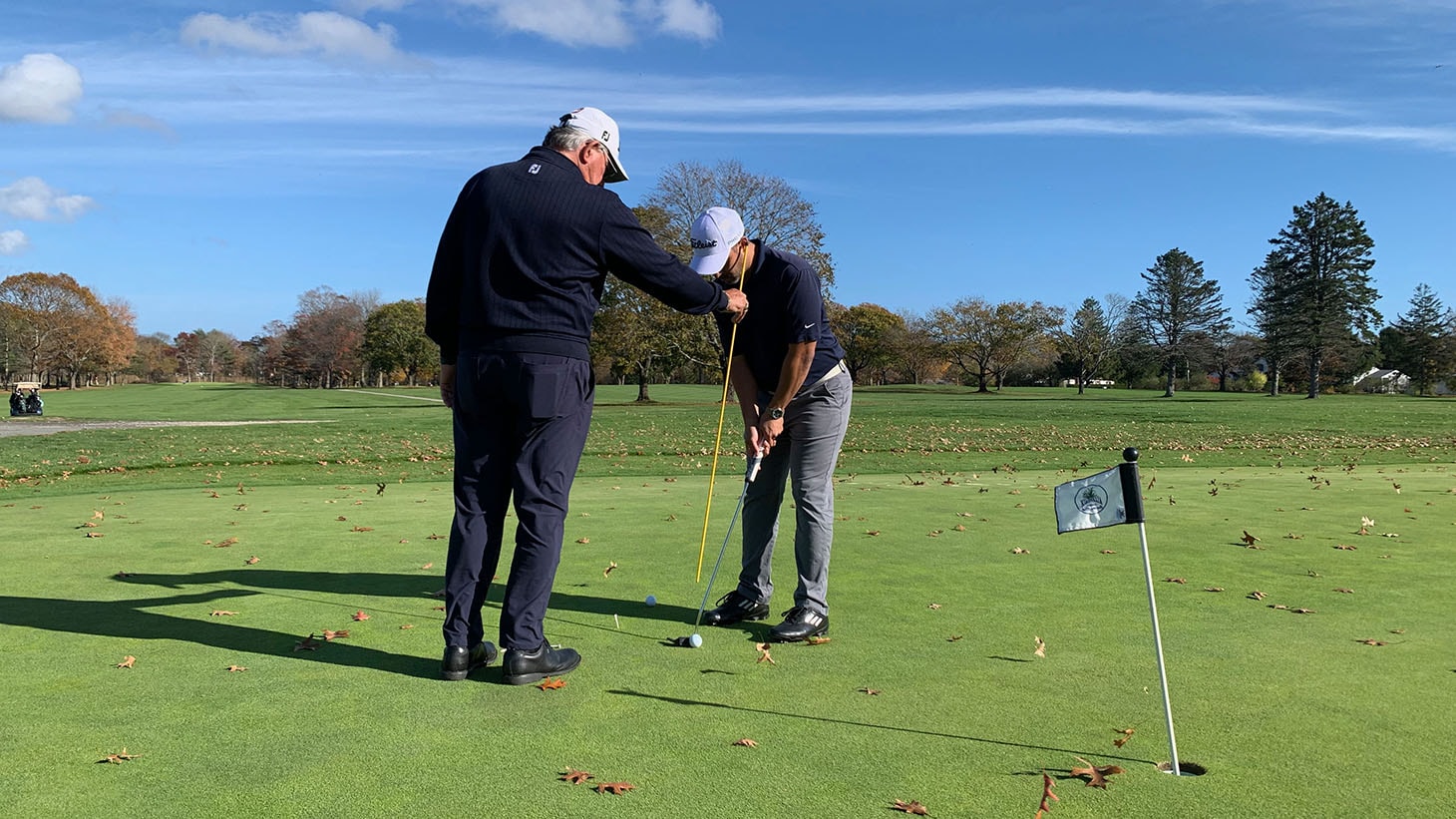 To kick of Fabian's short putting lesson, Bob Giusti marked a straight, uphill putt and then worked through a few fundamentals. First, set up and ball position. As Bob told Fabian, "Weight favors the left side a little bit, steady head, left eye behind the ball. You want to be able to see the ball, and your line from the ball to the hole."1/6
To kick of Fabian's short putting lesson, Bob Giusti marked a straight, uphill putt and then worked through a few fundamentals. First, set up and ball position. As Bob told Fabian, "Weight favors the left side a little bit, steady head, left eye behind the ball. You want to be able to see the ball, and your line from the ball to the hole."1/6
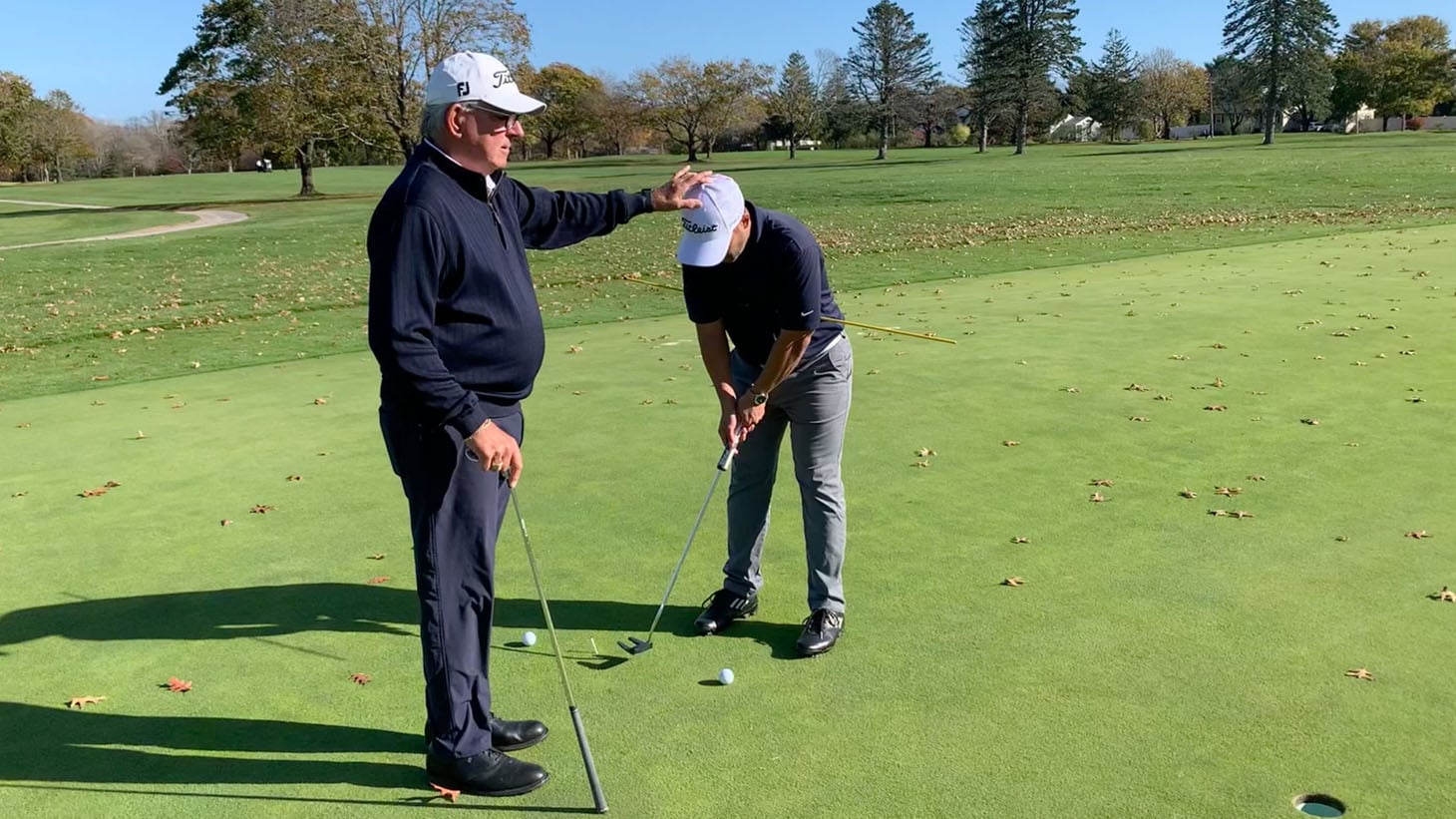 Bob then placed an alignment stick under Fabian's arms. "The arms and the hands are quiet." 2/6
Bob then placed an alignment stick under Fabian's arms. "The arms and the hands are quiet." 2/6
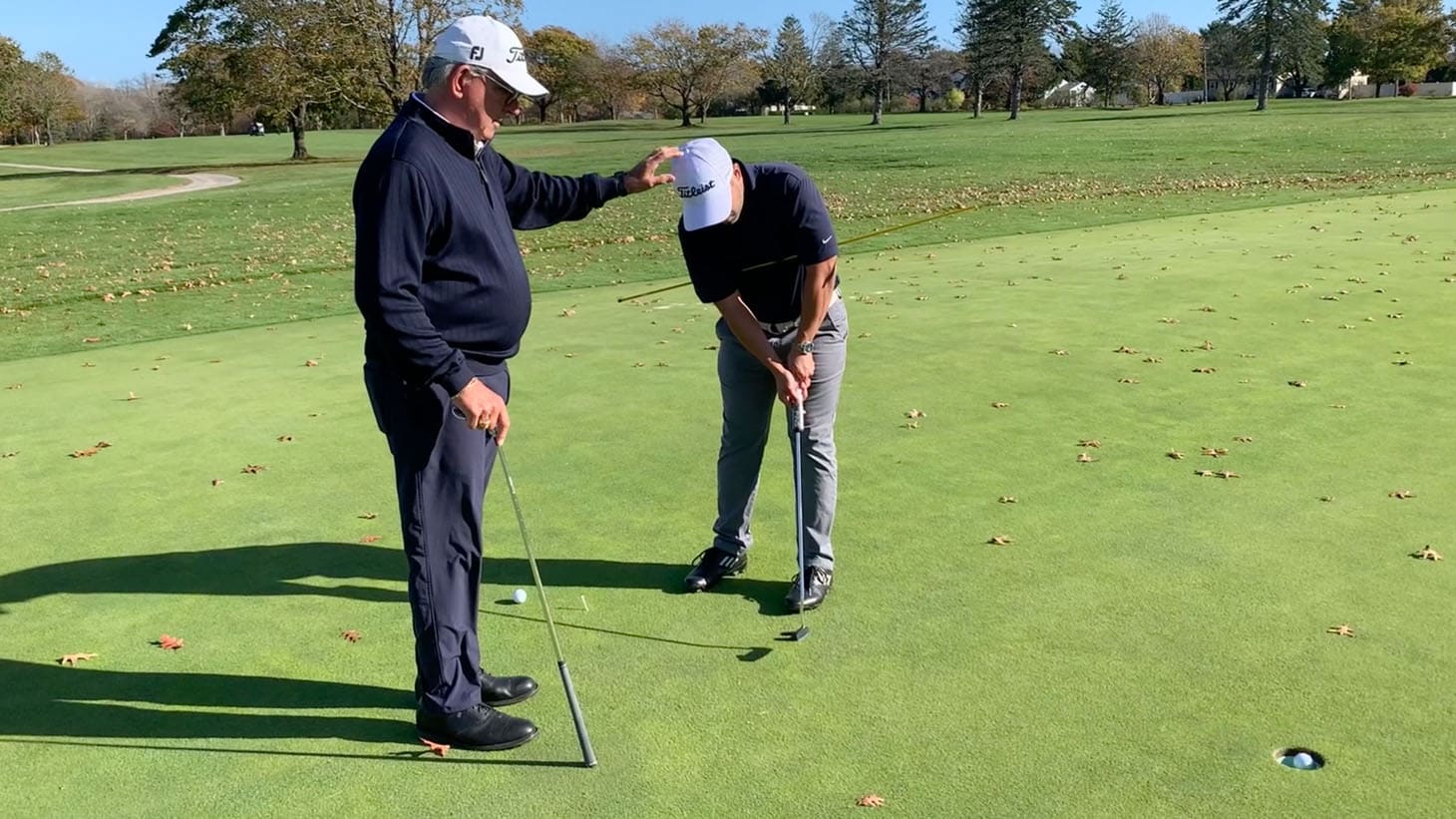 "...You move the putter, hands and arms together, as one unit, by rocking your shoulders."3/6
"...You move the putter, hands and arms together, as one unit, by rocking your shoulders."3/6
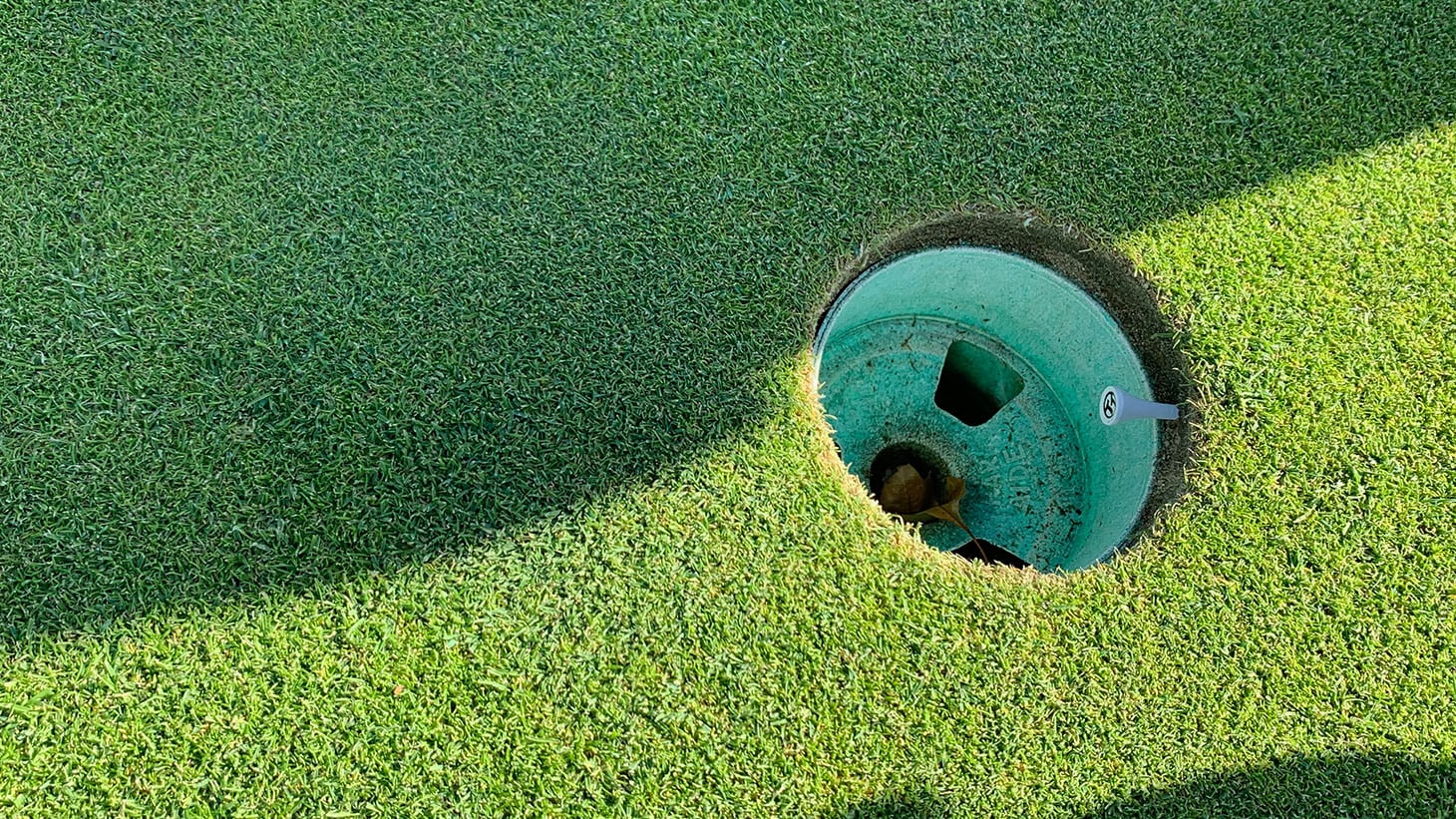 Once Fabian got the feel for a "one-piece" stroke, Bob shared a great drill, embedding a tee horizontally inside the back edge of the cup.4/6
Once Fabian got the feel for a "one-piece" stroke, Bob shared a great drill, embedding a tee horizontally inside the back edge of the cup.4/6
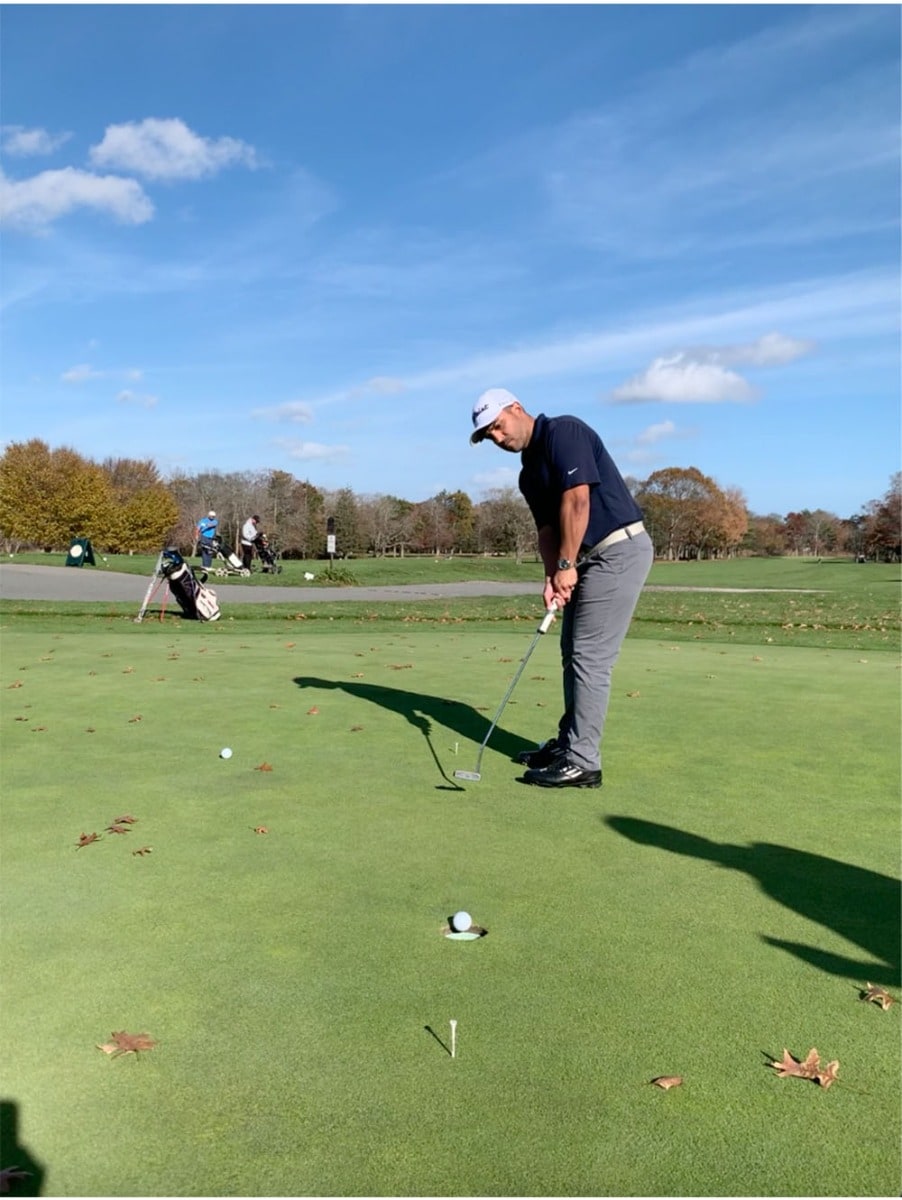 This provides a great visual and serves as a guide for the proper speed to hole putts.5/6
This provides a great visual and serves as a guide for the proper speed to hole putts.5/6
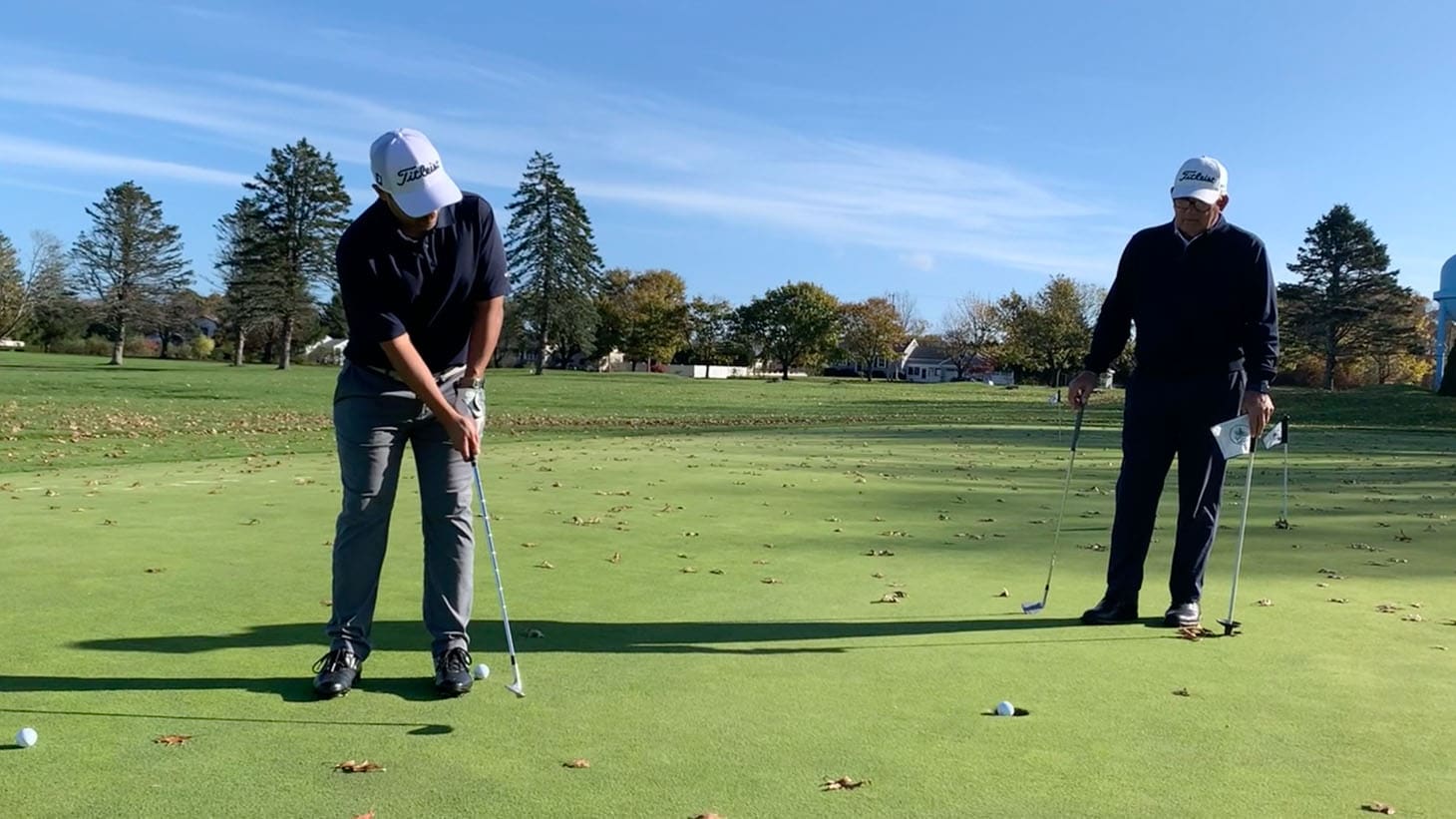 Lastly, to work on the fundamentals of a steady head, connected stroke and centered contact on the face of the putter, Bob had Fabian hit some putts with the leading edge of his sand wedge. If you can sink putts with a bladed wedge, putting with your flat stick becomes child's play. 6/6
Lastly, to work on the fundamentals of a steady head, connected stroke and centered contact on the face of the putter, Bob had Fabian hit some putts with the leading edge of his sand wedge. If you can sink putts with a bladed wedge, putting with your flat stick becomes child's play. 6/6
Next, Bob had Fabian grab his Vokey sand wedge as he explained, "Chipping is an extension of putting. It's the same rocking motion of the shoulders. Quiet hands. A lot of amateurs, I feel as though they try to lift the ball up. They're also using the same club all the time – usually a 60-degree, 58-degree wedge – instead of using the right tool for the shot at hand. I'm a firm believer, you've got to look at what's in front of you and get the ball rolling on the green. One third carry two thirds roll, and just feel it."
Check out the gallery below for more of Bob's chipping keys.
/teamtitleist/cfs-file/__key/telligent-evolution-components-attachments/13-1258-00-00-00-12-53-72/001-07-B-0006-Vert-Chipping-Shaft-Lean-IMG-7211.jpg/teamtitleist/cfs-file/__key/telligent-evolution-components-attachments/13-1258-00-00-00-12-53-71/002-08-B-0007-Vert-Chipping-Coin-Drill-3-Screen-Shot-2023-02-20-at-11.27.58-AM.jpg/teamtitleist/cfs-file/__key/telligent-evolution-components-attachments/13-1258-00-00-00-12-53-70/003-9-B-0021-Horiz-Chipping-Coin-Drill-1-IMG-7212.jpg/teamtitleist/cfs-file/__key/telligent-evolution-components-attachments/13-1258-00-00-00-12-53-69/004-10-B-0020-Horiz-Chipping-Coin-Drill-2-Screen-Shot-2023-02-20-at-11.25.18-AM.jpg/teamtitleist/cfs-file/__key/telligent-evolution-components-attachments/13-1258-00-00-00-12-53-68/005-11-B-one-third-two-thirds-0221223-1460x821.png
 In Bob's philosophy, chipping utilizes the same motion as putting, but with some slight adjustments - one of which is a slight forward lean of the shaft at address and through impact.1/5
In Bob's philosophy, chipping utilizes the same motion as putting, but with some slight adjustments - one of which is a slight forward lean of the shaft at address and through impact.1/5
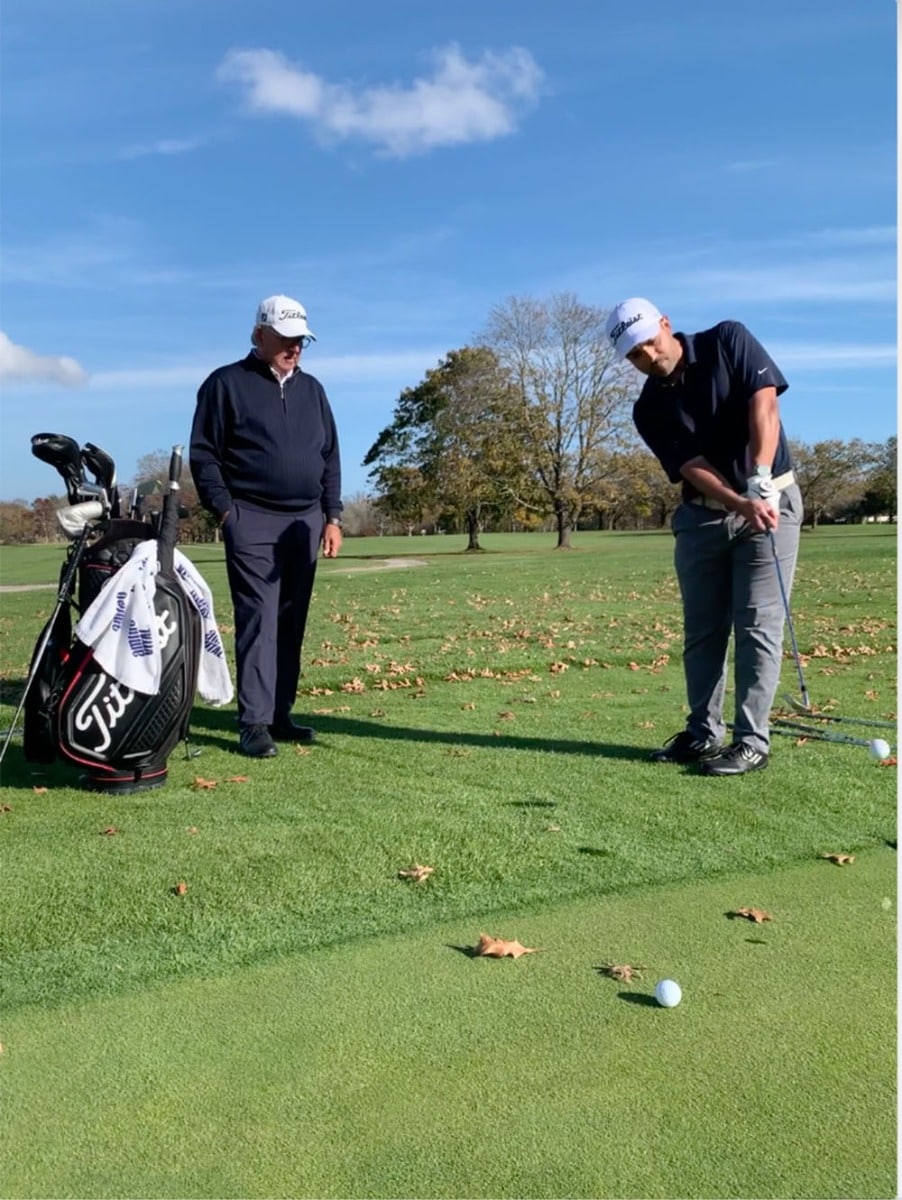 When the hands beat the clubface to impact, you make crisp, consistent contact. No scooping.2/5
When the hands beat the clubface to impact, you make crisp, consistent contact. No scooping.2/5
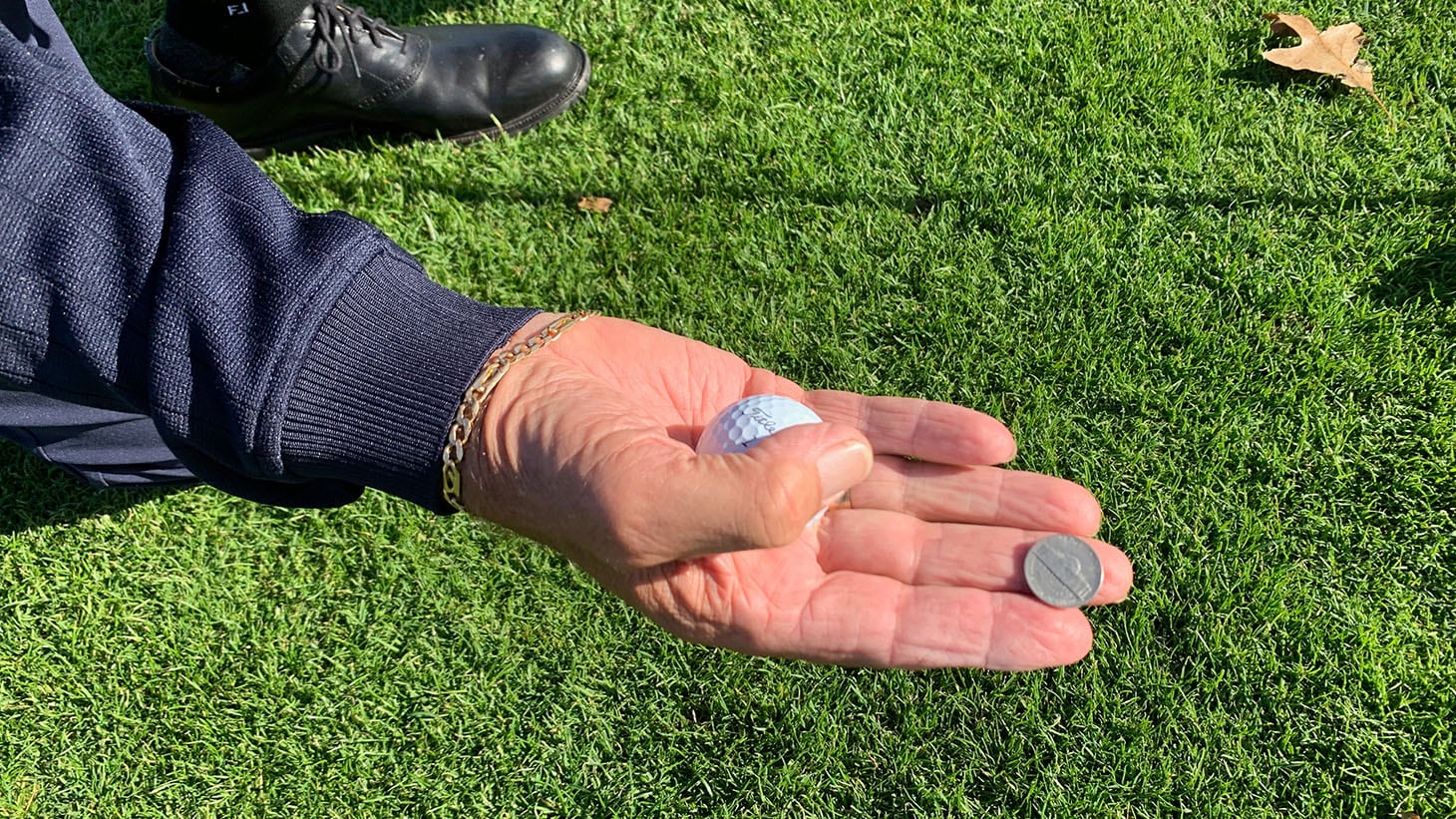 Where you land the bottom of the wedge is a crucial skill in chipping. To build this skill, Bob placed a nickel on the turf, just in front of the golf ball.3/5
Where you land the bottom of the wedge is a crucial skill in chipping. To build this skill, Bob placed a nickel on the turf, just in front of the golf ball.3/5
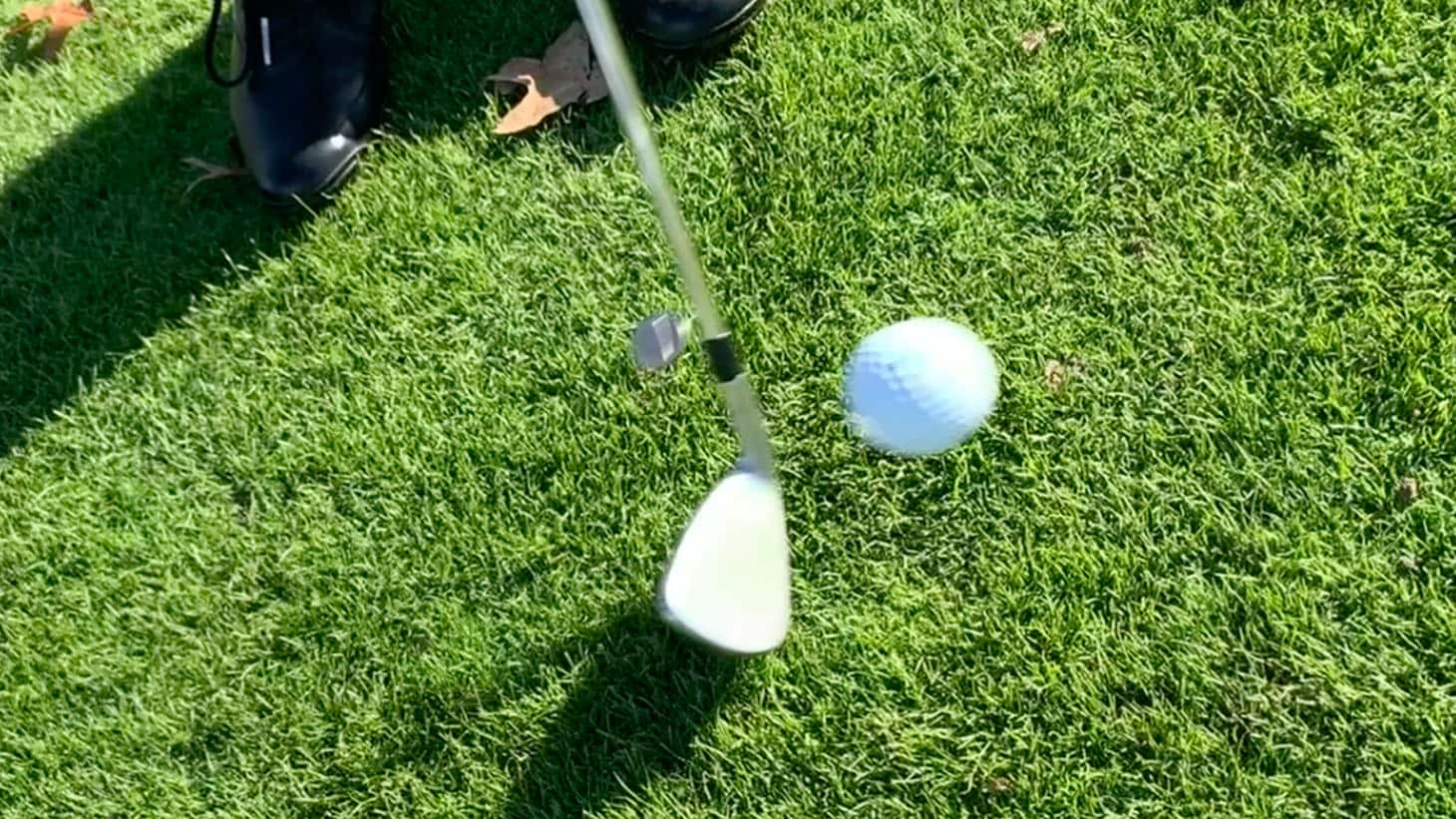 When Fabian was able to land the club just beyond the ball, the nickel flew ahead, too – great feedback for proper technique.4/5
When Fabian was able to land the club just beyond the ball, the nickel flew ahead, too – great feedback for proper technique.4/5
 The most important takeaway for Fabian was Bob's concept of flying the ball one-third of the way to the hole and letting it roll the remaining two-thirds of the distance. Fabian drained this chip and as Bob explained, "Guessing at your landing spot makes distance control very difficult in chipping and it doesn't help you develop feel around the greens. The one-third, two-thirds system is easy for anyone apply. It's easy to pace off and divide by three and it gives you a reference point for adjusting club selection and dealing with varying green conditions."5/5
The most important takeaway for Fabian was Bob's concept of flying the ball one-third of the way to the hole and letting it roll the remaining two-thirds of the distance. Fabian drained this chip and as Bob explained, "Guessing at your landing spot makes distance control very difficult in chipping and it doesn't help you develop feel around the greens. The one-third, two-thirds system is easy for anyone apply. It's easy to pace off and divide by three and it gives you a reference point for adjusting club selection and dealing with varying green conditions."5/5
Armed with some clear short game concepts, it was time for Fabian and Skip to head to the first tee at Allendale, a 391-yard straight-forward par 4. As Fabian grabbed his driver and took a few practice swings, I asked Skip about on-course instruction.
"In my opinion," Skip said, "playing lessons are essential, because the golf swing and playing golf are two different things entirely. The practice tee is a very controlled environment – mats or perfect turf, flat lies, perpendicular lines. It's easy to get aligned and hit good shots on the range. On the course, no two lies are ever the same. No two shots are the same. Tee markers and hole designs are crooked. Alignment is much more difficult. You have to deal with elevation, wind, so many more variables.
On the lesson tee, we focus on mechanics and your technique. On the course, we need to focus on strategy and imagination and creating golf shots. And there are no do-overs. You have to learn to think – to plan, to commit and then to execute. It takes a lot of work and practice to build those skills. I always say, 'The golf swing is easy. Playing golf is difficult'. "
Check out the gallery below to see what Skip and Fabian worked on.
/teamtitleist/cfs-file/__key/telligent-evolution-components-attachments/13-1261-00-00-00-12-54-42/001-12-C-0003-Vert-Hole-1-Tee-Shot-Screen-Shot-2022-11-05-at-10.47.42-AM.jpg/teamtitleist/cfs-file/__key/telligent-evolution-components-attachments/13-1261-00-00-00-12-54-41/002-13-C-0012-Vert-Aim-High-WIndow-IMG-7245.jpg/teamtitleist/cfs-file/__key/telligent-evolution-components-attachments/13-1261-00-00-00-12-54-40/003-14-C-0007-Horiz-Rough-Lie-1-Screen-Shot-2022-11-05-at-10.50.51-AM.jpg/teamtitleist/cfs-file/__key/telligent-evolution-components-attachments/13-1261-00-00-00-12-54-39/004-15-C-0006-Horiz-Rough-Lie-2-Screen-Shot-2022-11-05-at-10.51.45-AM.jpg/teamtitleist/cfs-file/__key/telligent-evolution-components-attachments/13-1261-00-00-00-12-54-38/005-16-C-0005-Horiz-Rough-Lie-3-Screen-Shot-2022-11-05-at-10.52.11-AM.jpg/teamtitleist/cfs-file/__key/telligent-evolution-components-attachments/13-1261-00-00-00-12-54-37/006-17-C-0013-Horiz-Par-5-Birdie-Putt-Screen-Shot-2022-11-05-at-10.53.11-AM.jpg/teamtitleist/cfs-file/__key/telligent-evolution-components-attachments/13-1261-00-00-00-12-54-36/007-18-D-0023-Horiz-Bunker-1-Screen-Shot-2022-11-05-at-10.54.41-AM.jpg/teamtitleist/cfs-file/__key/telligent-evolution-components-attachments/13-1261-00-00-00-12-54-35/008-19-D-0022-Horiz-Bunker-2-Screen-Shot-2022-11-05-at-10.55.08-AM.jpg/teamtitleist/cfs-file/__key/telligent-evolution-components-attachments/13-1261-00-00-00-12-54-34/009-22-C-0002-Horiz-Water-Hole-Approach-1-Screen-Shot-2022-11-05-at-10.58.18-AM.jpg/teamtitleist/cfs-file/__key/telligent-evolution-components-attachments/13-1261-00-00-00-12-54-33/010-23-C-0001-Horiz-Water-Hole-Approach-2-Screen-Shot-2022-11-05-at-10.57.40-AM.jpg/teamtitleist/cfs-file/__key/telligent-evolution-components-attachments/13-1261-00-00-00-12-54-32/011-24-E-0004-Horiz-Skip-Fairway-Metal-Screen-Shot-2022-11-05-at-11.00.10-AM.jpg/teamtitleist/cfs-file/__key/telligent-evolution-components-attachments/13-1261-00-00-00-12-54-31/012-25-E-0016-Horiz-Hybrid-Fabian-2-Screen-Shot-2022-11-05-at-10.59.45-AM.jpg/teamtitleist/cfs-file/__key/telligent-evolution-components-attachments/13-1261-00-00-00-12-54-30/013-26-F-0000-Vert-Skip-and-Fabian-IMG-7323.jpg
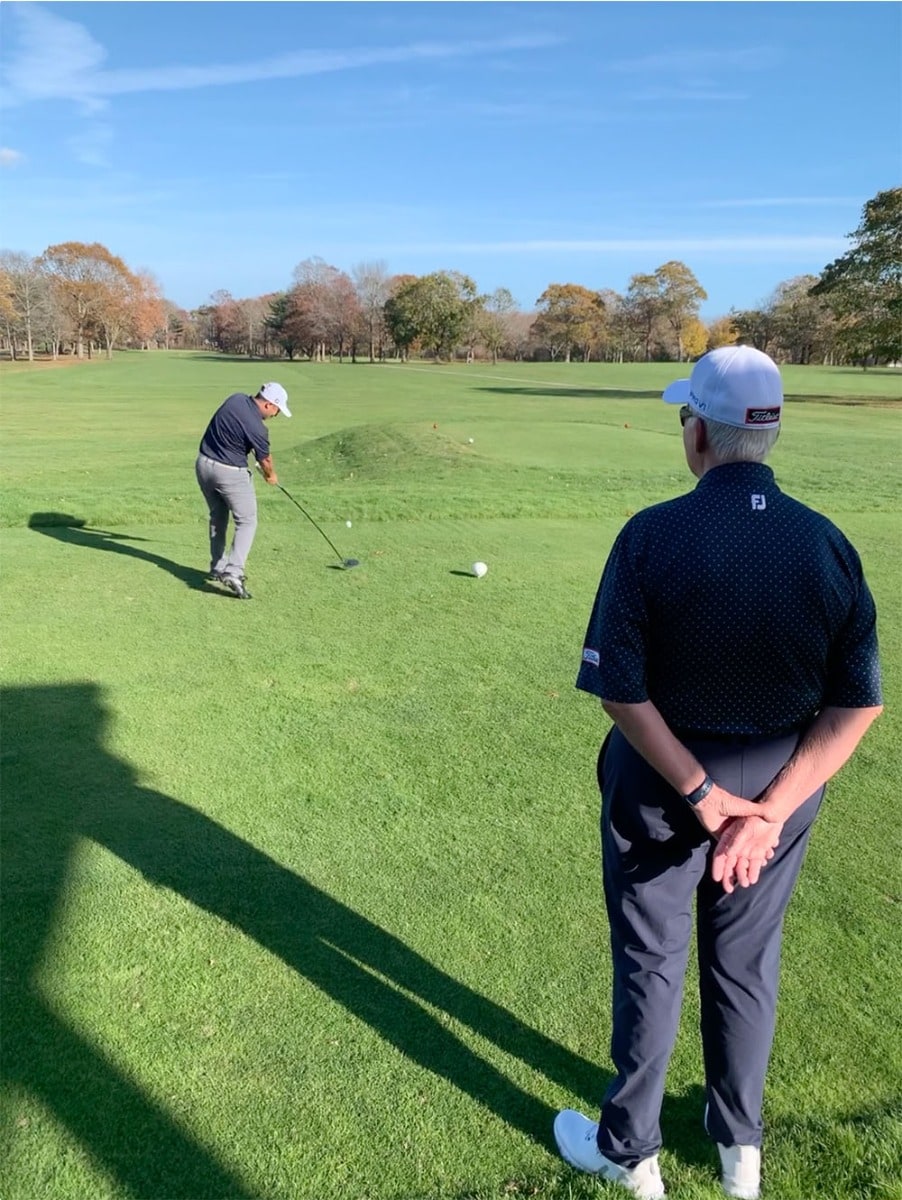 "One of the first things I look at in a playing lesson is how a player is influenced by the architect," Skip said. "I want my players to know their predominant ball flight and strategize around that. Far too often golfers get in trouble trying to play shots that fit the design of a hole rather than managing the course around their shot shape and playing to their strengths."1/13
"One of the first things I look at in a playing lesson is how a player is influenced by the architect," Skip said. "I want my players to know their predominant ball flight and strategize around that. Far too often golfers get in trouble trying to play shots that fit the design of a hole rather than managing the course around their shot shape and playing to their strengths."1/13
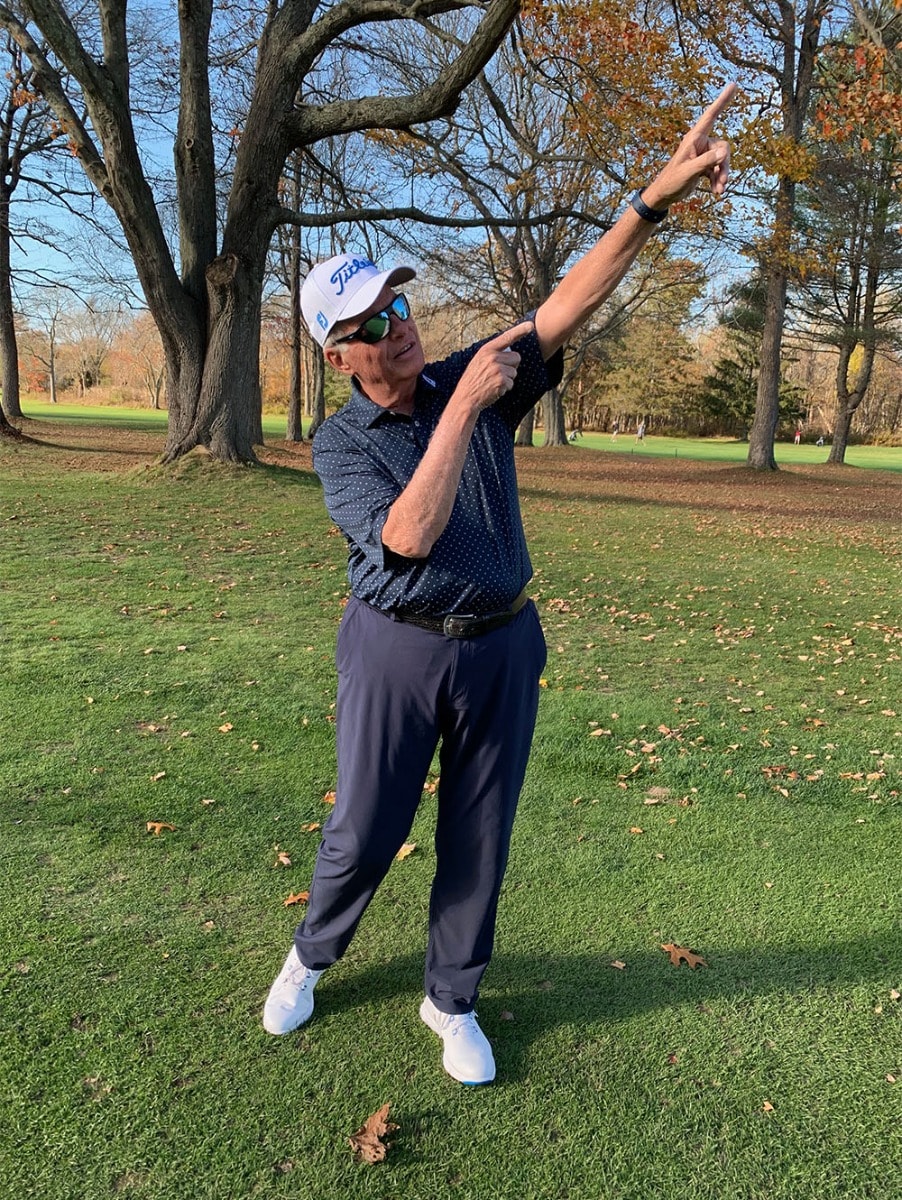 Before hitting his short iron approach into the green on No.1, Fabian started making some small practice swings, hinging the club to waist height and adjusting the position of the club shaft. Skip stopped him and explained that even very good players fall into the trap of playing golf swing out on the course instead of playing golf. His solution? "I gave Fabian a visual. I pointed to a cloud above and beyond the green. I said, 'Now, I want you focus on the cloud and put the ball through the cloud.' That's a player thought, not a swing thought – ball flight and trajectory. Tom Brady didn't think about his elbow position when he threw in a game. That's a practice thought."2/13
Before hitting his short iron approach into the green on No.1, Fabian started making some small practice swings, hinging the club to waist height and adjusting the position of the club shaft. Skip stopped him and explained that even very good players fall into the trap of playing golf swing out on the course instead of playing golf. His solution? "I gave Fabian a visual. I pointed to a cloud above and beyond the green. I said, 'Now, I want you focus on the cloud and put the ball through the cloud.' That's a player thought, not a swing thought – ball flight and trajectory. Tom Brady didn't think about his elbow position when he threw in a game. That's a practice thought."2/13
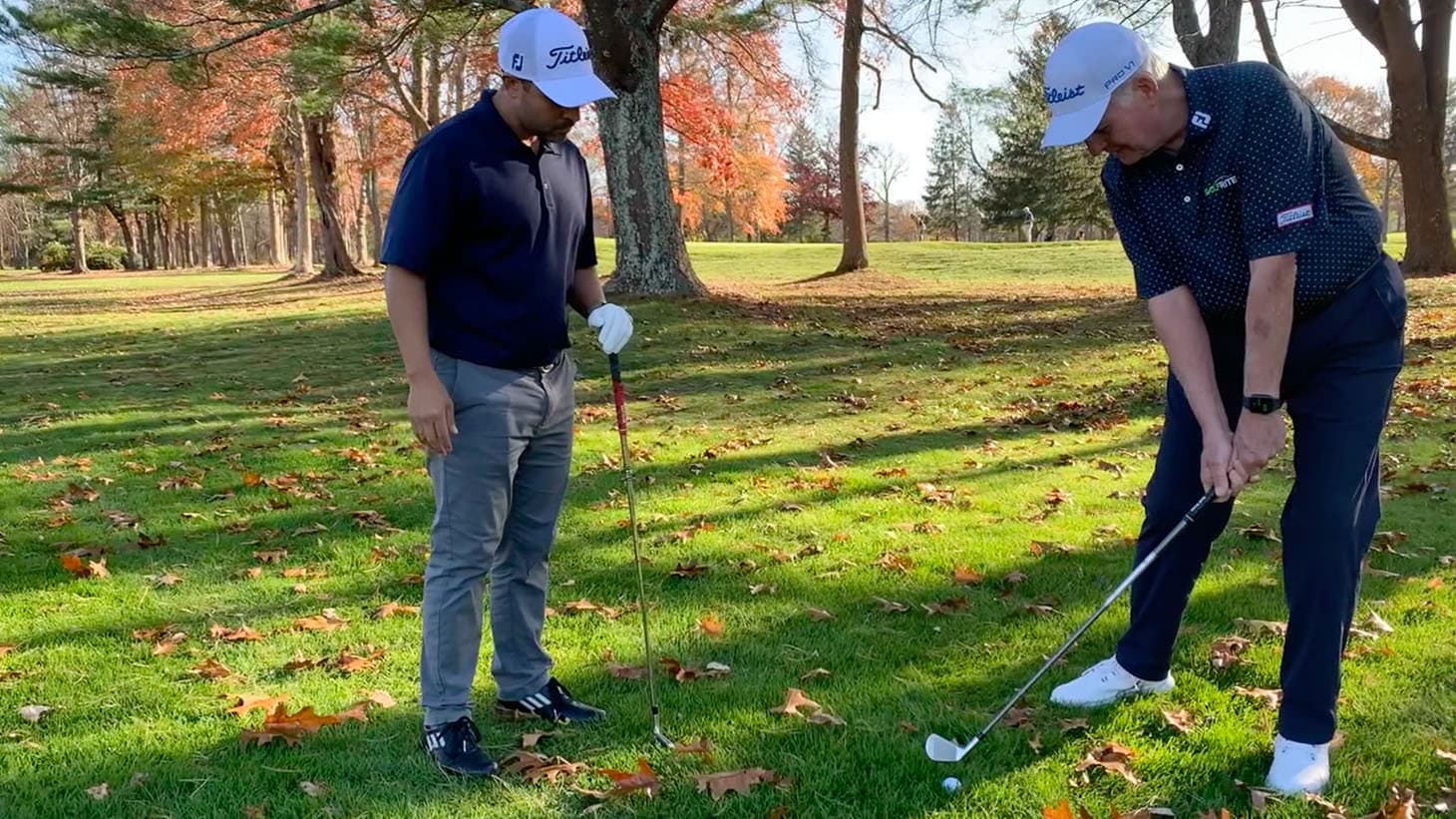 No. 2 at Allendale is a long par 4. Fabian hooked his drive and found the left rough, well over 200 yards from the green. Fabian asked about technique, so Skip demonstrated, but first talked strategy. "What you should be thinking here," Skip explained, "is get back into position. That means back on the fairway. Too often players bite off more that they can chew when they're in trouble. Advance the ball, yes, but the most important thing is to get the ball back onto the short grass." 3/13
No. 2 at Allendale is a long par 4. Fabian hooked his drive and found the left rough, well over 200 yards from the green. Fabian asked about technique, so Skip demonstrated, but first talked strategy. "What you should be thinking here," Skip explained, "is get back into position. That means back on the fairway. Too often players bite off more that they can chew when they're in trouble. Advance the ball, yes, but the most important thing is to get the ball back onto the short grass." 3/13
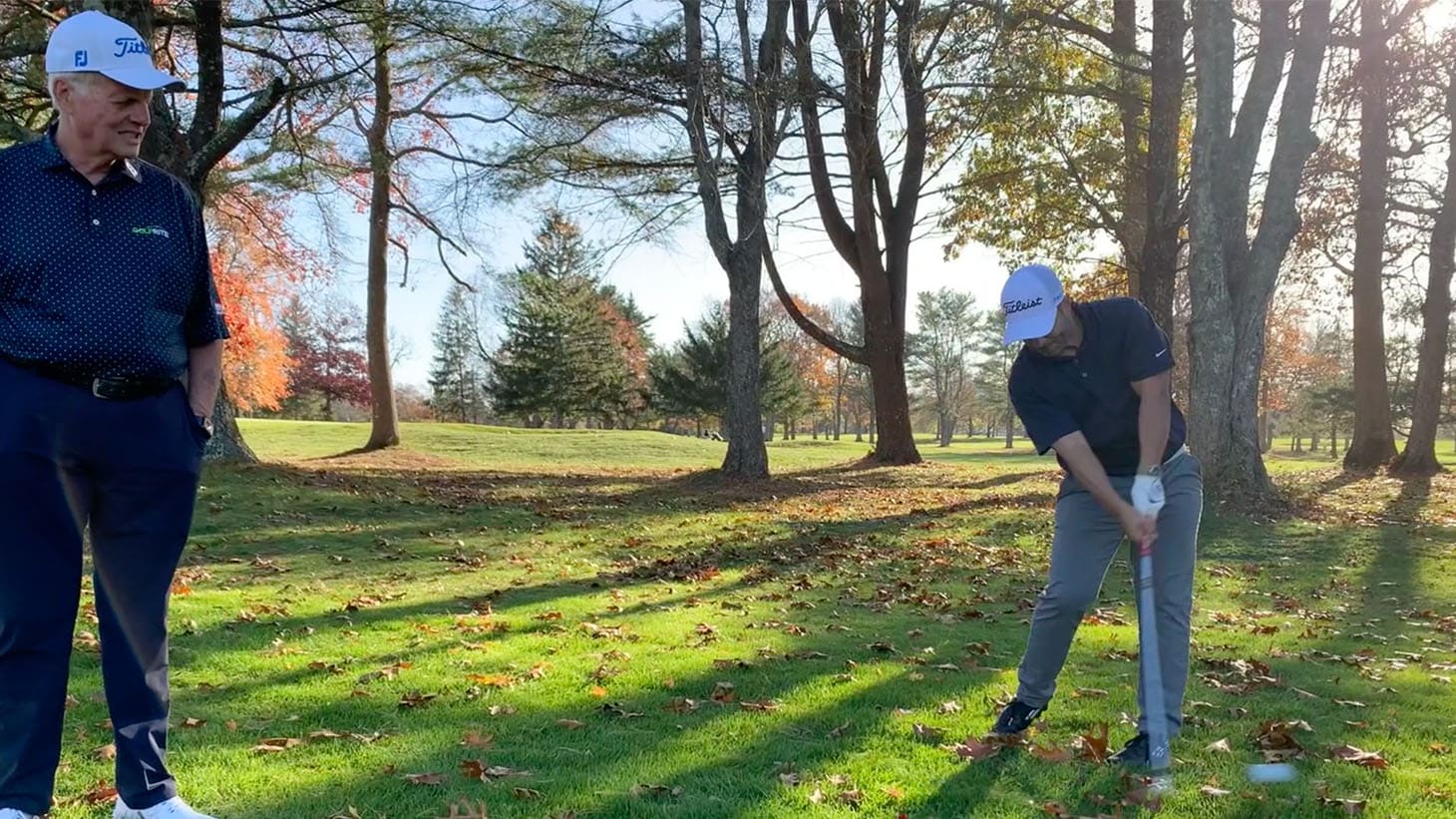 Technique-wise, Fabian applied Skip's adjustments - ball position back to promote a steeper angle of attack, forward shaft lean on the club and a more lofted club to account for the de-lofted clubface. The plan was to hit a low, running shot down the fairway.4/13
Technique-wise, Fabian applied Skip's adjustments - ball position back to promote a steeper angle of attack, forward shaft lean on the club and a more lofted club to account for the de-lofted clubface. The plan was to hit a low, running shot down the fairway.4/13
 No over-swinging or attempting to hoist the ball in the air on this swing. A beautiful escape that left Fabian inside 100 yards from the center of the fairway.5/13
No over-swinging or attempting to hoist the ball in the air on this swing. A beautiful escape that left Fabian inside 100 yards from the center of the fairway.5/13
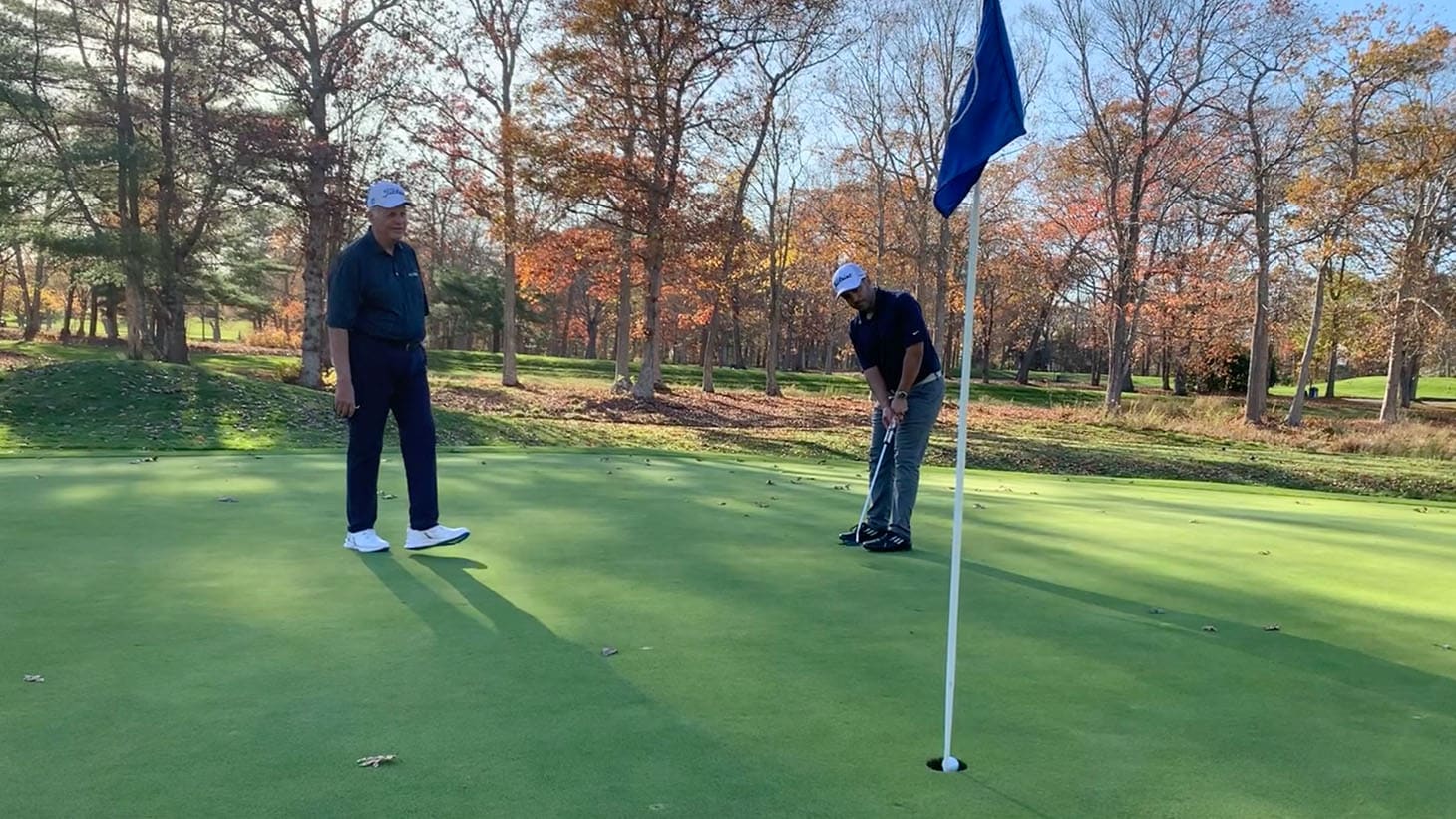 Fabian hit a sand wedge to twelve feet and drained this putt for par. The lesson? "Fabian hit a poor tee shot. But he hit his second shot to 80 yards. He put it in the middle of the green and sank his putt. So, the tee shot did not hurt him. So often though, golfers snort and get all bent out of shape when they hit a poor drive. You have to understand that it rarely hurts your score. Unless you're O.B. or in a hazard, you're still in the hole. You just have to think calmly and manage the next few shots ahead of you." 6/13
Fabian hit a sand wedge to twelve feet and drained this putt for par. The lesson? "Fabian hit a poor tee shot. But he hit his second shot to 80 yards. He put it in the middle of the green and sank his putt. So, the tee shot did not hurt him. So often though, golfers snort and get all bent out of shape when they hit a poor drive. You have to understand that it rarely hurts your score. Unless you're O.B. or in a hazard, you're still in the hole. You just have to think calmly and manage the next few shots ahead of you." 6/13
 The next hole was a par-3 and Fabian found a greenside bunker. A great opportunity to learn some sand basics. The big takeaways? "You have to have a lot of cupping or extension in the lead wrist. When you cup the lead wrist on the back swing and you cup it on the follow through, that allows the back of the sole to do all the work."7/13
The next hole was a par-3 and Fabian found a greenside bunker. A great opportunity to learn some sand basics. The big takeaways? "You have to have a lot of cupping or extension in the lead wrist. When you cup the lead wrist on the back swing and you cup it on the follow through, that allows the back of the sole to do all the work."7/13
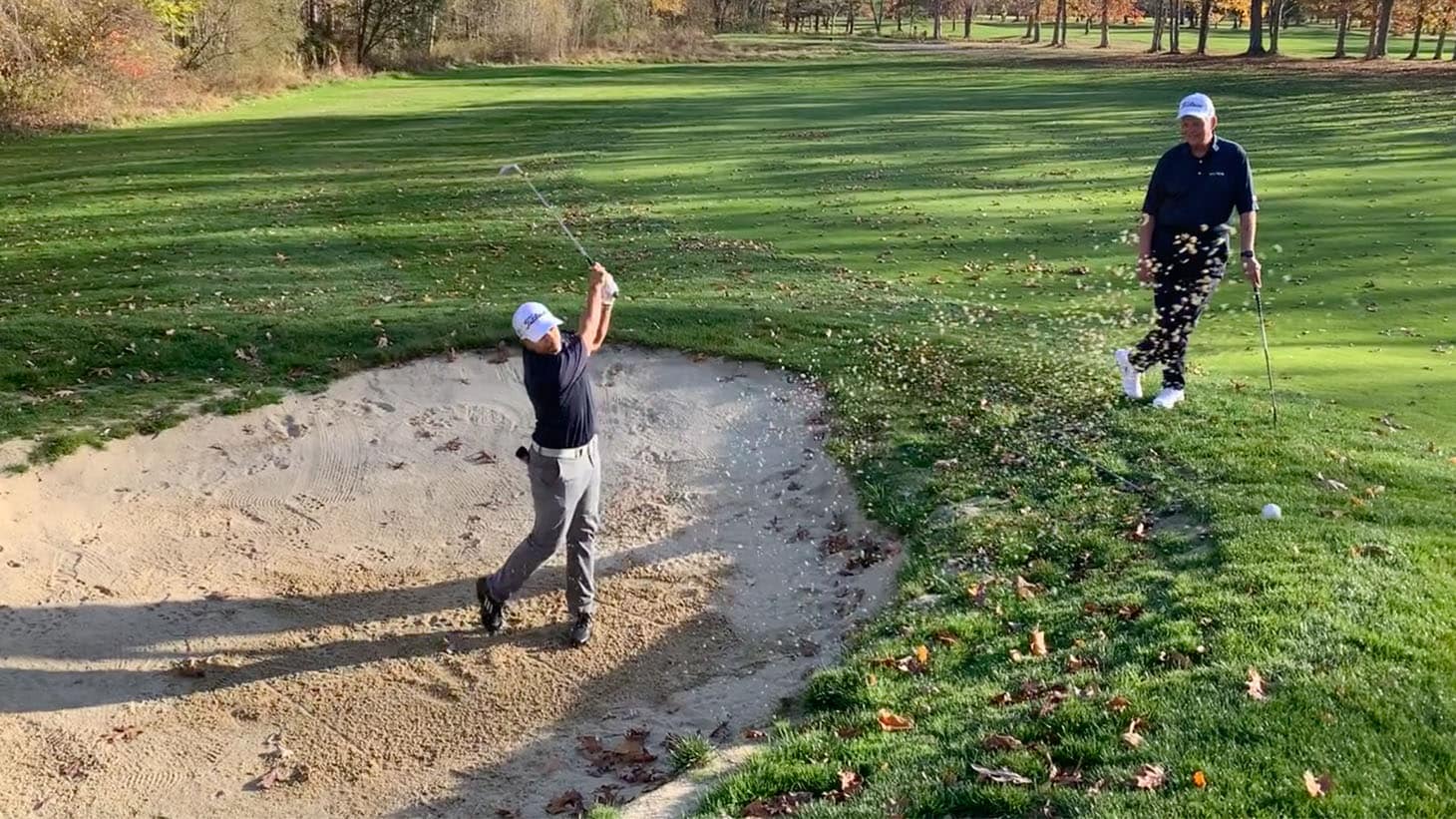 Fabian tried a shot himself and asked how the ball would go straight when the face of his sand wedge was opened so far to the right of target. "Because you're not touching the ball with the clubface," Skip responded. "You're only displacing sand. If you swing in the direction of the flag, that's where the displaced sand will go. And the golf ball will follow."8/13
Fabian tried a shot himself and asked how the ball would go straight when the face of his sand wedge was opened so far to the right of target. "Because you're not touching the ball with the clubface," Skip responded. "You're only displacing sand. If you swing in the direction of the flag, that's where the displaced sand will go. And the golf ball will follow."8/13
 Fabian hit a perfect drive on the next hole, a par-4 dogleg right. But as we approached his ball in the fairway, Fabian noted the water fronting the green and said "Oh, boy." This earned him a playful, but stern reprimand from Skip. "Now there's thirty yards between the water and the front of that green. Why would you ever react to the fact that the architect put water there? You might miss a little left or right. You might miss a little short, but you're not going to hit it 50 yards short. I want you to picture a window on the 14th floor above that flagstick. Put the golf ball there."9/13
Fabian hit a perfect drive on the next hole, a par-4 dogleg right. But as we approached his ball in the fairway, Fabian noted the water fronting the green and said "Oh, boy." This earned him a playful, but stern reprimand from Skip. "Now there's thirty yards between the water and the front of that green. Why would you ever react to the fact that the architect put water there? You might miss a little left or right. You might miss a little short, but you're not going to hit it 50 yards short. I want you to picture a window on the 14th floor above that flagstick. Put the golf ball there."9/13
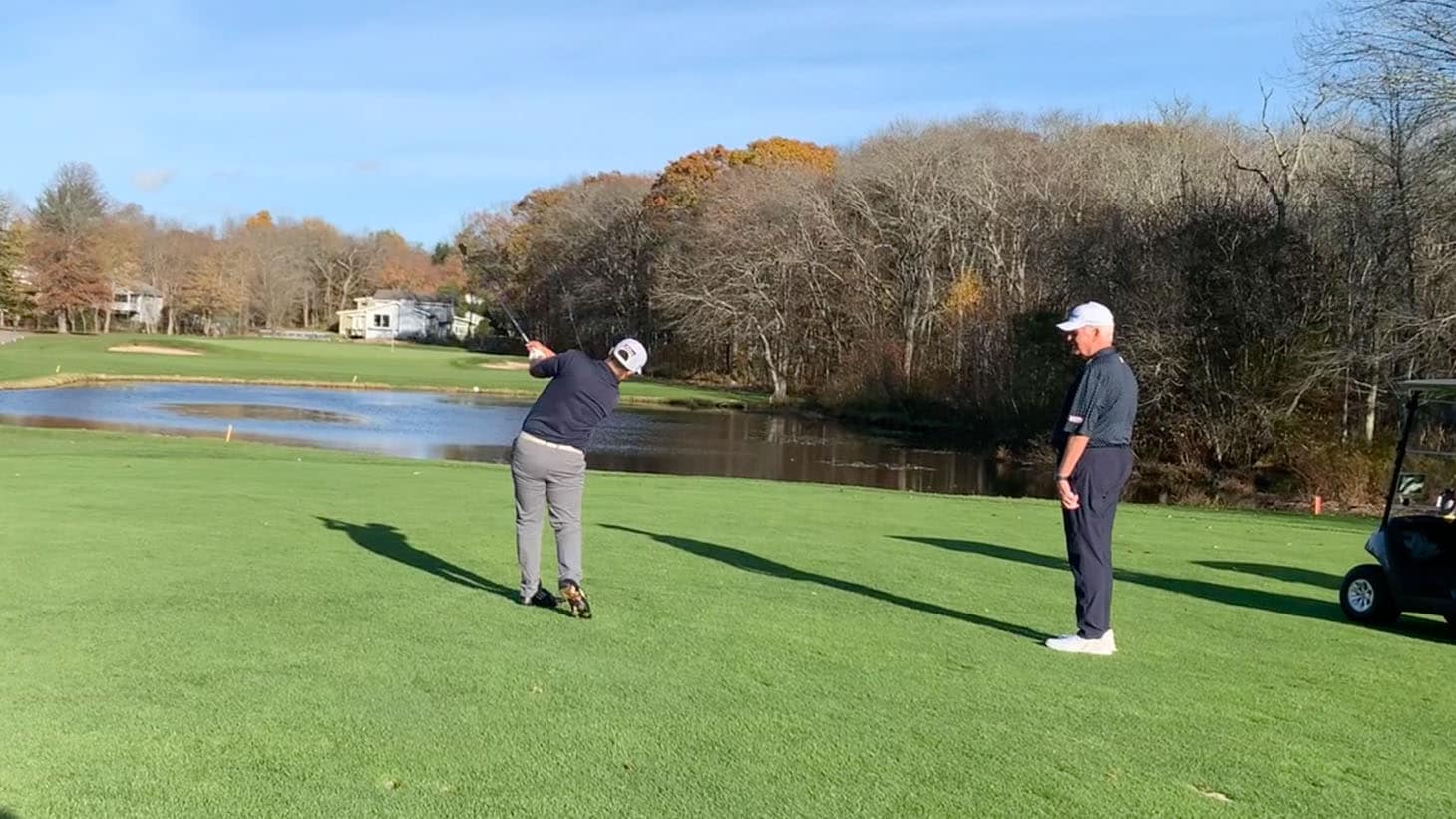 Fabian thinned his approach a bit, but as Skip predicted, he was hole-high, never in danger of losing his ball in the pond.10/13
Fabian thinned his approach a bit, but as Skip predicted, he was hole-high, never in danger of losing his ball in the pond.10/13
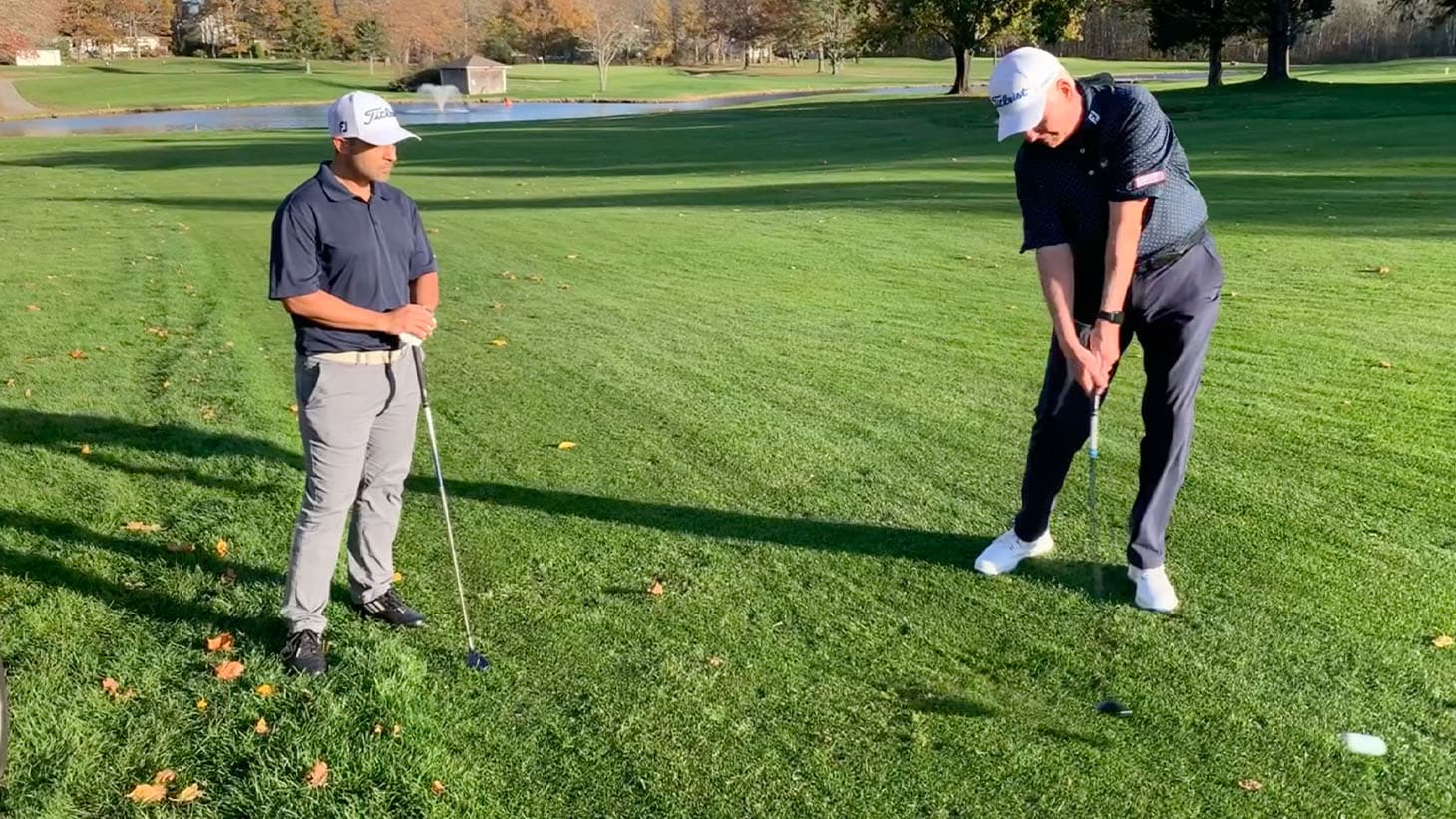 The last hole Fabian and Skip played was a long uphill par-5 that narrowed as we got closer to the green. Fabian asked for some help with the hybrid shot he had left. As Skip dropped a ball and demonstrated a shot, he told a story of playing in a Senior U.S. Open and hitting a scoreboard with a hybrid shot – 45 degrees right of where he intended. "For a long time, I hated hybrids! Couldn't hit them. Because I didn't understand how they need to interact with the turf."11/13
The last hole Fabian and Skip played was a long uphill par-5 that narrowed as we got closer to the green. Fabian asked for some help with the hybrid shot he had left. As Skip dropped a ball and demonstrated a shot, he told a story of playing in a Senior U.S. Open and hitting a scoreboard with a hybrid shot – 45 degrees right of where he intended. "For a long time, I hated hybrids! Couldn't hit them. Because I didn't understand how they need to interact with the turf."11/13
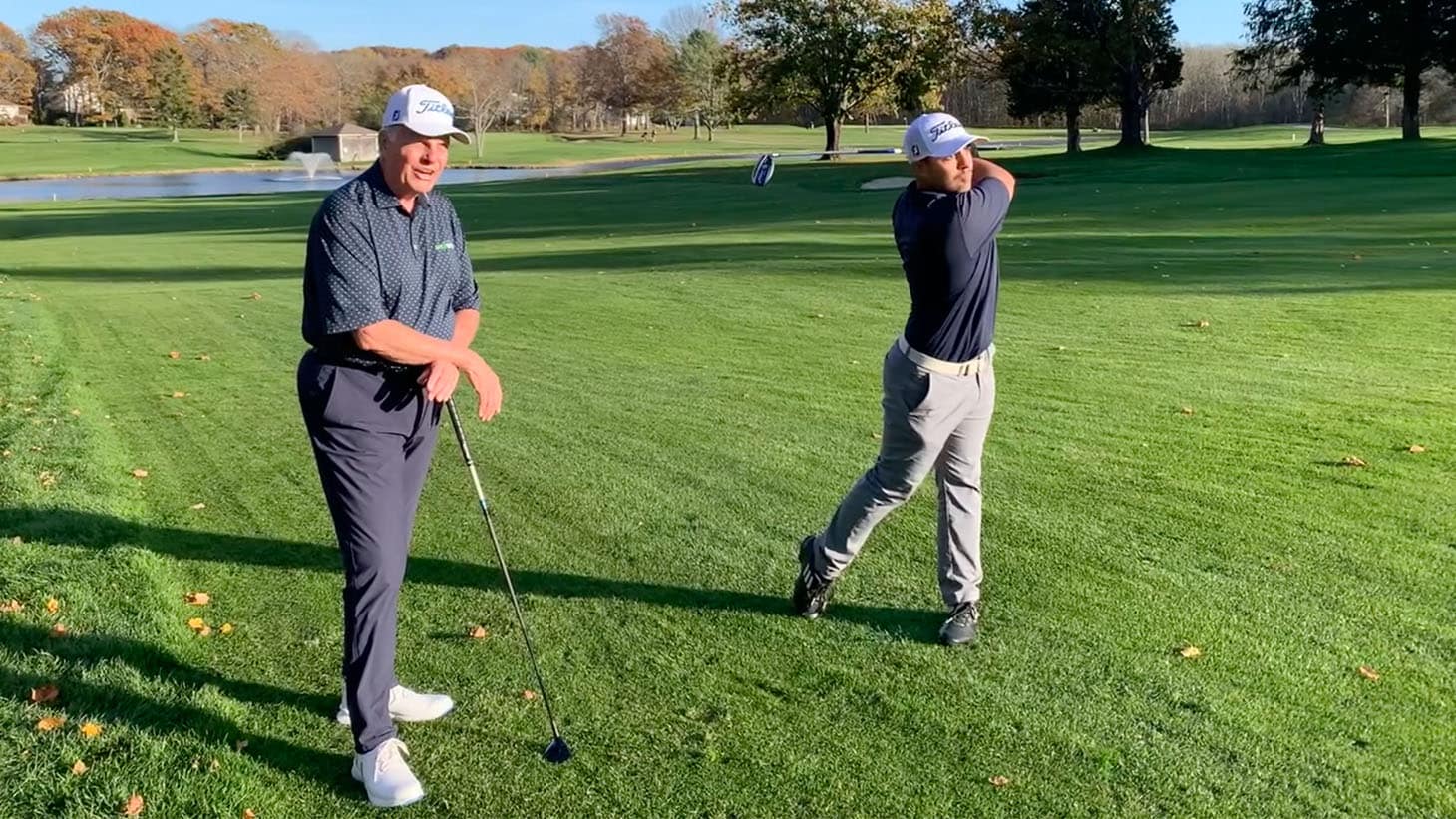 As Fabian stepped in to hit his shot, Skip continued, "Pretend your golf ball is lying on top of a cherry pie. With a fairway metal, we're trying to just barely break the top of the crust. With an iron, we need to get down, through the crust entirely, and get a little bit of the filling. With a hybrid, you need to get deeper into the crust than you would with the fairway metal, but you don't want to take any filling. You'll hear the difference, too, as you change the depth of your divots and interact with the turf differently." 12/13
As Fabian stepped in to hit his shot, Skip continued, "Pretend your golf ball is lying on top of a cherry pie. With a fairway metal, we're trying to just barely break the top of the crust. With an iron, we need to get down, through the crust entirely, and get a little bit of the filling. With a hybrid, you need to get deeper into the crust than you would with the fairway metal, but you don't want to take any filling. You'll hear the difference, too, as you change the depth of your divots and interact with the turf differently." 12/13
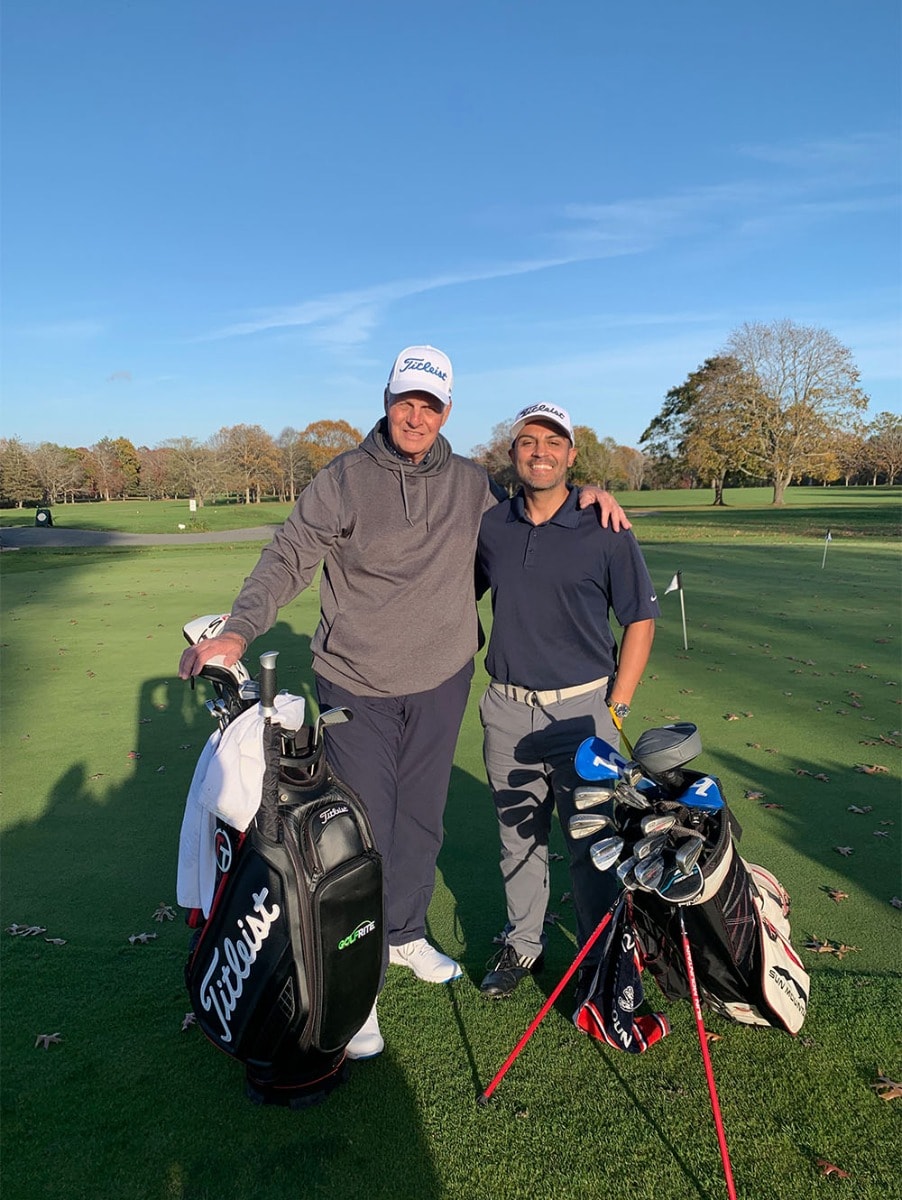 Fabian was all smiles after his afternoon with Skip. He, told me, "I learned more today than I have all season. Just in this three-hour playing lesson."
“Well if that's how you feel," Skip chimed in, " you're buying the beers!" Fabian did so, happily, capping off a very memorable and enjoyable day of learning.
13/13
Fabian was all smiles after his afternoon with Skip. He, told me, "I learned more today than I have all season. Just in this three-hour playing lesson."
“Well if that's how you feel," Skip chimed in, " you're buying the beers!" Fabian did so, happily, capping off a very memorable and enjoyable day of learning.
13/13
During their playing lesson Skip did touch on technique at times (adjustments from the rough and bunkers, for example), but his main focus was helping Fabian to think and navigate his way around the golf course.
"Today was no different than what I see all the time. The importance of a playing lesson is that it shows you that if you think better, you're able to perform better athletically. Fabian saw that. Today was big for him because he experienced the difference between playing golf and playing golf swing. Now it's up to him to keep developing that player mindset."
Have you ever taken a playing lesson from an expert instructor? Please share your experiences in the comments below. We'd love to hear how it's helped your game!
#TeamTitleist